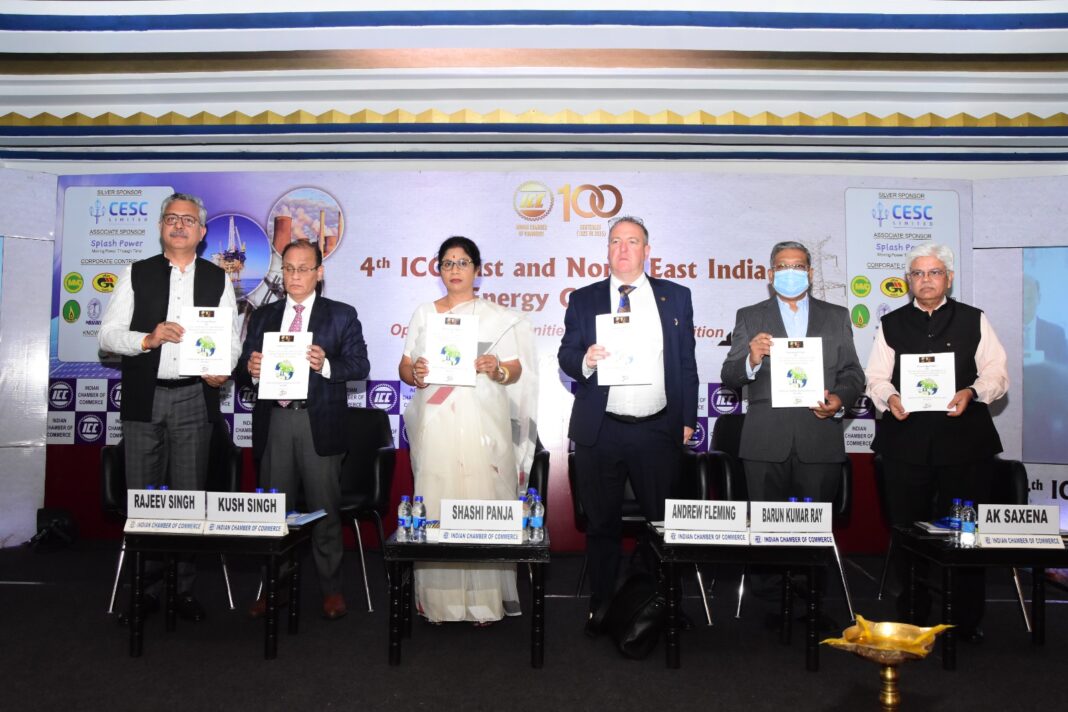The Indian Chamber of Commerce (ICC) today hosted the 4th East & North East India Energy Conclave in Kolkata, focusing on accelerating renewable energy adoption and regional collaboration. The event brought together key policymakers and experts including Chief Guest Dr. Shashi Panja, Minister in Charge, Department of Industry, Commerce and Enterprise, Government of West Bengal; Mr. Andrew Fleming, British Deputy High Commissioner, Kolkata; Mr. Barun Kumar Ray, Additional Chief Secretary, Non-Conventional Energy and Renewable Energy Sources (NRES) Department, Government of West Bengal; Mr. Rajeev Singh, Director General, ICC; and Mr. A.K. Saxena, Senior Director, TERI.
Opening the Conclave, Dr. Shashi Panja highlighted West Bengal’s commitment to clean energy and industrial growth. “West Bengal is proud to be at the forefront of India’s energy transition, driven by clean energy, regional collaboration, and innovation. Our strategic location, competitive costs, and infrastructure make us a natural hub for industry and renewable energy,” she said.
Dr. Panja outlined several large-scale initiatives taken up by the state government. She mentioned that a ₹16,000 crore, 1,600 MW supercritical thermal power plant by JSW Energy is coming up in Salboni. Another 125 MW solar PV farm in Goaltore, West Medinipur, which is jointly funded by the state (₹150 crore) and German Development Bank (₹600 crore). Floating solar projects across 30 dams with a combined potential of 3,567 MW are also in the process of implementation and 2,000-acre industrial park adjacent to the Salboni power project will come up.
Highlighting innovation, she added, “Our partnership with TERI is unlocking technologies like floating solar, agri-PV, BIPV, and battery storage. TERI is also helping the West Bengal Transport Corporation with electric bus and ferry storage.”
She emphasized the state’s growing EV ecosystem, with 318 charging stations and 68,000 EVs sold by early 2024. West Bengal’s renewable energy potential is immense—19,000 MW solar, 23,000 MW wind, and 2,864 MW biomass. “We are also exploring underground coal gasification in the Deocha Pachami coal block and pushing forward with our Green Hydrogen Policy and Renewable Manufacturing Policy to achieve 20% renewable energy by 2030,” Dr. Panja stated.
Barun Kumar Ray addressed the national context: “India’s goal of 500 GW renewable capacity by 2030 is ambitious. With 220 GW already achieved as of March 2025, substantial effort remains. Eastern and North Eastern India still depend heavily on thermal power, but opportunities in nuclear energy, solar, and hybrid systems are growing.”
He noted the state’s solar initiatives for agriculture, solar cold chains, and agro-PV systems. “We’re exploring wind, tidal, and pumped storage solutions, including using abandoned coal mines. A Green Zone in Sector V, developed with the British Deputy High Commission, will integrate rooftop solar, BIPV, and e-mobility,” he added. “This transition is expected to attract ₹70,000 crore in investment over five years.”
British Deputy High Commissioner Andrew Fleming reaffirmed the UK’s support, saying, “East and North East India have the resources and ambition to become a clean energy powerhouse. The UK brings world-class expertise and experience—having cut power sector emissions by over 70% since 1990 and generating more than half of our electricity from renewables. Our collaboration, from EV policy support in West Bengal to decentralised energy in the North East, is already producing results. Together, we can build a sustainable and resilient energy future.”
Mr. A.K. Saxena of TERI emphasized regional potential: “East and North East India hold over 218 GW of energy potential. However, energy consumption per capita in these regions remains below the national average. Affordability, innovation, and execution speed are vital.”
TERI’s roadmap includes solar parks in Odisha and Bihar, pumped storage in West Bengal, microgrids, smart metering, and expanded electric mobility. “We recommend forming an East & North East Energy Transition Council and integrating Distribution System Operators for future-ready grids,” Saxena said. “Our support for 1,200 electric buses in Kolkata reflects our commitment to urban decarbonisation.”
Rajeev Singh of ICC concluded, “West Bengal is leading from the front in sustainable growth. Within just two months of BGPS, over 20 MoUs are already operational. As India’s sixth-largest economy, West Bengal is setting a powerful example for clean, inclusive development. With 1.4 billion aspirations, India’s energy future must be green.”


